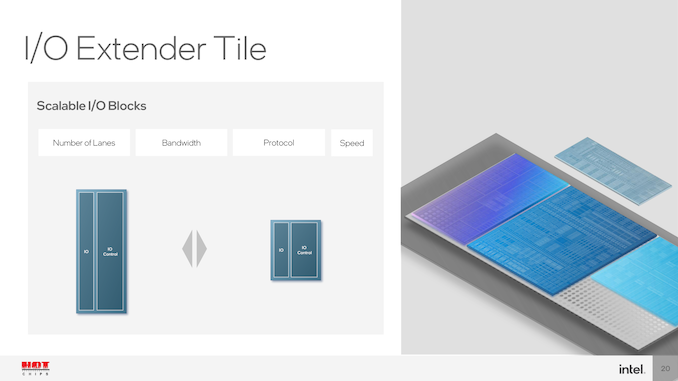Intel Unveils Meteor Lake Architecture: Intel 4 Heralds the Disaggregated Future of Mobile CPUs
by Gavin Bonshor on September 19, 2023 11:35 AM ESTI/O Tile: Extended and Scalable Depending on Segment
The smallest of Meteor Lake's tiles is the I/O tile, which is primarily designed to offer additional connectivity features. This, of course, is down to two things; specific vendor's needs and the grade of processor itself. As Meteor Lake is scalable, the I/O tile is perhaps the crux of enabling specific features such as Thunderbolt 4 on devices. A lower-end Intel Core 3 Meteor Lake chip is likely to drop flashy I/O-specific features such as TB4 to save on cost, as entry-level notebooks aren't going to use it.
The higher end of the Meteor Lake product stack will feature Thunderbolt 4, and although it will be on the I/O tile for notebook vendors to utilize, having a scalable I/O fabric allows Intel to implement a modular approach to I/O features instead of one that is more one size fits all. The I/O tile includes additional PCIe lanes, but this number will vary depending on the processor itself; a higher-end chip will have more for additional storage needs, whereas a lower-end chip will have the minimum for connectivity and whatnot. Something else is that the I/O tile isn't a PCIe Coherent Fabric, which means data can only be transferred without the support for cache coherency between memory and devices.











107 Comments
View All Comments
Orfosaurio - Saturday, September 23, 2023 - link
Please, answer why. I have detected at least some "bias", but why you said that he is a liar?KPOM - Tuesday, September 19, 2023 - link
It does seem that the N3B process isn’t yielding great efficiency improvements. Any chance Apple will be paying a visit to Intel Foundries in the near future? A19 or A20 on Intel 20A?tipoo - Tuesday, September 19, 2023 - link
I'd say there's a real chance as they expect a density crossover in 2025lemurbutton - Tuesday, September 19, 2023 - link
My M1 draws 0.2w - 5w during Geekbench ST. A17 Pro is going to draw considerably less.dontlistentome - Wednesday, September 20, 2023 - link
Good to see the RDF is still alive and strong. Guess we are getting closer to Halloween.tipoo - Wednesday, September 20, 2023 - link
That's weird because the lower power A17 draws up to 14W on app launch, and those numbers are not remotely true for M1. It's impressive compared to high power x86 CPUs, but those numbers just aren't right.lemurbutton - Thursday, September 21, 2023 - link
It's true. Anyone with an M1 can prove it. Run GB5 and open powermetrics in the terminal. It's easy to verify.Orfosaurio - Saturday, September 23, 2023 - link
Have multiple sources verified that peak power draw?bji - Tuesday, September 19, 2023 - link
Off-topic. Just go away please.danielzhang - Thursday, September 21, 2023 - link
You need to rethink.This is stupid comparion and hilarious conclusion.First of all, Geekbench cannot fully reflect x86 performance, you should compare R23 with m2 max and 13900H, the full load efficiency is actually similar.
Second, you exaggerate the efficiency gap by comparing a low powered designed mobile phone soc with desktop chip, intel has low power 15W chips like i7 1335u has great single thread performance as well.
At full load, there is efficiency gap but the gap is not big at full load but at light load, apple leads probably 1.5x.